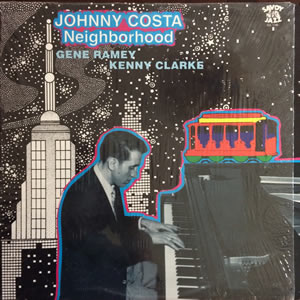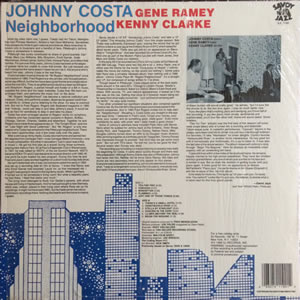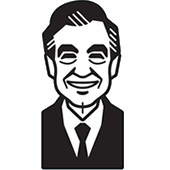Neighborhood (Johnny Costa LP)
Artist: Johnny Costa
Date: 1989
Format: LP
Label: Savoy Jazz
Catalog: SJL 1190


Track List
Side A
- Tea For Two
- Caravan
- Manhattan
- Flamingo
- Just One Of Those Things
Side B
- There's A Small Hotel
- Honeysuckle Rose
- Stella By Starlight
- Dancing in the Dark
- La Mer (Beyond the Sea)
- Begin the Beguine
Liner Notes
Most big cities claim one, I guess. Toledo had Art Tatum, Memphis has had Phineas Newborn, Boston 's had Dave McKenna. Sometimes they escape city limits to gain national prominence. Many times they're known only to musicians and a handful of fans. Pittsburgh 's Johnny Costa is somewhere in between.
Pittsburgh has surely contributed its share of grand pianists: Earl Hines, Mary Lou Williams, Billy Strayhorn, Erroll Garner, Dodo Marmarosa, Ahmad Jamal, Sonny Clark, Horace Parlan, and others less familiar. For just over thirty years, Johnny Costa has been at the edges of greater fame but unable to cross that border. But just because you don't recognize the name doesn't mean he can't do it. Ask anyone who's heard him play. Johnny Costa is the real thing.
Costa has been musical director for Mr. Rogers' Neighborhood since its inception in 1965. Fred Rogers is a very private, very focused person, some say difficult, but the two have been good friends and collaborators since the mid-50s. They're as gifted and productive a team as Ellington and Strayhorn. Rogers, a pianist himself and holder of a BA in music, supplies the lyrics and the basic melodies. Costa then fills them out, arranges them, and performs the music “live” on the show.
Mister Rogers' Neighborhood has become a national institution and treasure. Costa, who performs unseen, deserves far greater credit than he admits to. Unless you're listening to the show, it's easy to overlook him. But not to Fred Rogers. Rogers told Keyboard Magazine in 1985 that “nobody...could just step in and take Johnny's place. It would be just as hard for somebody to step in and take my place."
Costa has even arranged several of Rogers ' works for symphony orchestra and has conducted special concerts in Boston, Buffalo, Chicago, Denver, Orlando, Seattle and elsewhere. Together he and Rogers have made three appearances on The Tonight Show and one on Late Night with David Letterman. But Mister Rogers' Neighborhood is only one reason why Costa has remained in the Pittsburgh neighborhood. There have been opportunities, and a few close calls over the years.
After a stint as an Army medic, Costa returned home and earned two BA degrees from Carnegie Tech—now Carnegie-Mellon University—one in music composition, the other in education (“just in case I was a flop in music”). He got his first jobs as a soloist during those summers, playing near Asbury Park , NJ at Paul's Edgewater Club in Wanamassa. In 1951 he was called by WDTV, of the old Dumont Network. WDTV became KDKA-TV and Costa became its musical director until 1965. At one point he even hosted his own program. During this time he and Fred and Josie Carey worked together on a short-lived Sunday kids show.
He can't remember who it was, but someone called him early in 1955 and set up a recording date for him at Savoy. “I knew that Savoy was who Erroll Garner had recorded ‘Laura” for, so that impressed me. I thought I was going to record in this big fancy studio. When I got there, it turned out to be somebody's living room! But what a beautiful piano he had there. I liked that piano very much.”
The living room belonged to Rudy Van Gelder's parents, with whom he was still living in Hackensack. And he had just bought a new Steinway which was, indeed, placed in their living room where Rudy setup his recordings. It might not have been NBC, but he made some marvelous and historic recordings there. Nothing like hearth and the home to inspire, I guess.
Savoy issued a 10” EP Introducing Johnny Costa and later a 12” LP called The Amazing Johnny Costa from this single session. Bob Theile was sufficiently impressed upon hearing the record that he got Johnny a twice-a-year gig at the Embers Room in NYC which lasted for about seven years. Theile also got Johnny an appearance on Steve Allen's Tonight Show. And later recorded him on three Coral LPs, the third one as part of the Modern Piano Quartet with Hank Jones, Dick Marx and Eddie Costa (no relation).
In the early-60s he recorded two LPs for Sonny Lester at Dot Records with Milt DeLugg. There were two 45s done for J. Arthur Rank, one of which was the theme for the movie Conspiracy of Hearts (“unfortunately the movie did nothing, so the record did nothing”). Some years later there was a privately released album, then nothing until a 1986 album Johnny Costa Plays Mister Rogers' Neighborhood. It's a straight jazz LP, but composed of songs written for the show.
Though based in Pittsburgh, Costa played some of the best piano spots around in the early 60s: Chicago 's London House, Wexler's Theatrical Bar in Cleveland, Baker's in Detroit, Miami 's Eden Rock and others. With records, TV, and niteclub appearances, it looked as if his star was on the rise. Getting that close to it however meant being too far away from what really moved him. “I just grew tired of not being with my family,” he says quite frankly.
Two other unrelated but significant situations also conspired against Costa's rise. By the mid-60s that grand piano sound was passé to the record companies. And in 1965 Fred Rogers invited him to help start the Neighborhood. Recalling it, Costa looks you straightin-the-eye and says firmly "I believed in Fred's work. Forget your money, your fame, your ‘career' and do something good, really good.” Even more confidently he adds, with pride “and I really made a good choice.”
Some of Johnny's admirers have included Peter Nero (still Bernie Neiro when he subbed for Johnny back at the Embers), Victor Borge, Buddy Rich, Jack Teagarden, Tommy Dorsey, Nathan Davis, Mike Douglas (Johnny turned down an offer to be Douglas' music director). After jamming together at a birthday party for Teagarden, Tommy Dorsey was impressed enough to promise “that he'd help me get some more work.” But not with TD's band, "He told me ‘you're too good for that.'” Several weeks later Dorsey was dead.
The recording you're holding (or maybe listening to already) was really the beginning for Costa. It came about quickly though and there was little preparation. Although Kenny Clarke was also a Pittsburgher, Johnny had never met him. Neither did he know Gene Ramey. But bass and drums are very secondary here and only appear on four pieces. Everyone was prepared for something, but no one seemed to know just what. “I was so arrangement-conscious then (on piano), everybody was. But I wish I'd have played more jazz, like on ‘Honeysuckle Rose.' Some of these (tunes) still sound pretty good,” he admits, “but I'd sure like the chance to do the rest over again. I play so much better now.”
If you like piano that's exciting, jazzy and swinging, you'll love half of this recording. If you like piano more ornate, sentimental and sophisticated, you'll love the other half. Some will sound dated. Some timeless. “Tea For Two” actually was the first take of the session (all tunes were single takes) and is turned into a stunning and elaborate Tatum-esque suite. A masterful performance. “Caravan” begins in the sleepy, early dawn and hits its ‘stride' in a rush hour ride through midtown. For favorites, I'll take “ Manhattan ” for sheer delights. Costa's favorite, “Honeysuckle Rose,” is another minor masterpiece. He has great fun with it harmonically and rhythmically. It's a joy to listen to. It was also the last take of the actual session. The album closes with Johnny's romp through “Begin the Beguine.” Here he displays an irresistible urban urgency with an unrelenting left hand.
Costa still lives within a few miles of his boyhood home. He remains happily married to his high school sweetheart. They have two children and four grandchildren, any one of whom puts a smile on his face and a twinkle in eye. But so does the mention of getting busier with jazz piano again. It looks good for him: an appearance on Marian McPartland's Piano Jazz, his performance on the Queen Elizabeth II, and the re-issue of this, his first album.
Is he ready for more now? He lights up “oh yes—ooh yes. I'm ready now. You name it!” Looks like it's up to you, the listener, to decide what's in store next for this truly grand pianist.
—David Jaye
Jazz NOW/WDUQ Radio, Pittsburgh
Credits
With Gene Ramey (bass) and Kenny Clarke (drums)
Original sessions produced by Fred Mendelsohn
Reissue producer: Joe Fields (suggested by Dave Fabilli)
Engineer: Rudy Van Gelder
Recorded at: Van Gelder Recording Studio, Hackensack, NJ on 2/26/55
Assembly: Malcolm Addey
Mastering Engineer: Joe Brescio, The Cutting Room-NYC
Art Direction: Dick Smith
Previously Issued on Savoy 12052 & 15056
© 1989 SJ Records, Inc.
